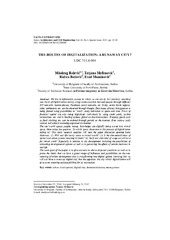Приказ основних података о документу
The Routes of digitalization: a runaway city?
| dc.creator | Ralević, Miodrag | |
| dc.creator | Mrđenović, Tatjana | |
| dc.creator | Božović, Ružica | |
| dc.creator | Muminović, Esad | |
| dc.date.accessioned | 2020-04-23T19:52:00Z | |
| dc.date.available | 2020-04-23T19:52:00Z | |
| dc.date.issued | 2017 | |
| dc.identifier.issn | 0354-4605 | |
| dc.identifier.issn | 2406-0860 | |
| dc.identifier.uri | https://raf.arh.bg.ac.rs/handle/123456789/619 | |
| dc.description.abstract | We live in informatics society in which we are slowly, but certainly, reaching new limits of digitalization mainly using communication between people through different ICT networks: mobile phones, Facebook, social networks, etc. Today, entire Earth, regions, cities, settlements, etc. can be observed through Google. Data bases of every living person is being formed using possibilities to “track” every individual in space and time. Flows of financial capital are also being digitalized: individuals by using credit cards, on/line transactions, etc. and in banking systems global on-line transactions. Everyday goods such as food, clothing, etc. can be ordered through portals on the internet. Even various study courses and schools are being organized via internet. The real world (space, people, money, knowledge) are digitally being moved into virtual space. Here arises the question: To which space dimension is this process of digitalization taking us? This main research question will lead the paper discussion opening basic dilemmas: (1) Will real life slowly move to virtual world? (2) Is the dematerialization of spatial and urban systems reaching its limits? (3) Shall and what kind of usage we will have for virtual world? Especially in relation to city development, including the possibilities of estimating developmental options as well as in perceiving the effects of certain decisions in real life. The main goal of the paper is to give answers to above disposed questions as well as to prove the thesis that we have a great range of influence and possibilities on the new meaning of urban development that is transforming into digital sphere, claiming that we will not have a runaway digital city, but the opposite: the city which digitalization will give a new meaning and possibilities for its re/creation. | en |
| dc.language.iso | en | sr |
| dc.publisher | Univerzitet u Nišu | sr |
| dc.relation | info:eu-repo/grantAgreement/MESTD/Technological Development (TD or TR)/36035/RS// | |
| dc.rights | openAccess | sr |
| dc.rights.uri | https://creativecommons.org/licenses/by-nc-nd/4.0/ | |
| dc.source | Facta Universitatis, Series: Architecture and Civil Engineering | sr |
| dc.subject | Urban development | sr |
| dc.subject | Digital city | sr |
| dc.subject | Dematerialization | sr |
| dc.subject | Management | sr |
| dc.title | The Routes of digitalization: a runaway city? | en |
| dc.type | article | sr |
| dc.rights.license | BY-NC-ND | sr |
| dcterms.abstract | Муминовић, Есад; Божовић, Ружица; Ралевић, Миодраг; Мрђеновић, Татјана; | |
| dc.citation.volume | 15 | |
| dc.citation.issue | 1 | |
| dc.citation.spage | 15 | |
| dc.citation.epage | 28 | |
| dc.citation.rank | M24 | |
| dc.identifier.doi | 10.2298/FUACE161122002R | |
| dc.identifier.fulltext | https://raf.arh.bg.ac.rs/bitstream/id/1643/2336-18867-1-PBFACTARalevicMMrdjenovicT.pdf | |
| dc.type.version | publishedVersion | sr |

